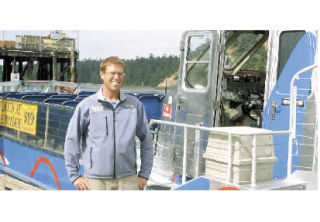For years folks on Central Whidbey Island have been dreaming about ferry service between Coupeville and Camano Island.
The Port of Coupeville seems to have taken the lead on the latest attempt to establish service between the two islands.
Examining the feasibility of ferry service comes at a time when people are looking at ways to combat increasing costs of fuel.
“The thing that is going to drive this is the price of fuel,” said Jim Patton, executive director for the Port of Coupeville.
When port officials developed their comprehensive plan, it placed ferry service as one of the goals the port would like to achieve. The port has also been approached by three different businesses about the possibility of providing ferry service.
Patton said several things need to happen before such a service could begin. The Coupeville Wharf would need some modifications, there needs to be a place for the ferry to land on Camano Island, and the business selected to offer ferry service would need funding as a start-up subsidy.
Finding a spot to land on Camano Island has been one of the hurdles preventing ferry runs from happening, but that may change. There is a possible location opening up in the next couple of years now that Cama Beach State Park has opened.
There are plans to build a pier at the new Camano Island park. Park Ranger Jeff Wheeler said the pier is currently going through the permitting process with the Army Corps of Engineers. He said it will be two to three years before the pier becomes a reality.
Wheeler said a decision hasn’t been made on whether to allow the pier to be used for passenger ferry service. Parking is a major issue for the new state park that currently has 187 spots.
He suggested that the port also examine using one of the two finger piers recently installed in the park, which are closer to parking.
County Commissioner John Dean, who makes the 90-minute car commute from Camano Island to Coupeville, said ferry service would bring in a nice infusion of tourist dollars.
“I’m certainly supportive of it,” Dean said.
The county would also benefit from the ferry service, by shortening the trip between Coupeville and Camano Island.
Dean didn’t know how much the county spends on transportation between the two islands, but it’s no doubt significant.
Patton said the port possesses a study the county produced in 1995 showing, at that time, the county spent $27,000 a month in transportation between the two islands. Since then the price of gas has tripled.
County officials are looking at the 13-year-old study. They will examine how it was compiled and then update the numbers.
Three business, two of them local, have expressed interest in operating the ferry service.
“We would love to be the ones to provide it,” said Terica Taylor, owner of Deception Pass Tours. She said the company would have to buy a second, smaller boat to offer the service.
Deception Pass Tours already did a trial run of the trip across Saratoga Passage. When Cama Beach State Park opened last month, Deception Pass Tours brought a boatload of officials to the celebration. The trip took a little more than 20 minutes to complete.
Whidbey/Seatac Shuttle and Victoria Express have also approached the Port of Coupeville about the possibility of ferry service.
To help ferry service get off the ground, Patton said a start-up subsidy would likely be needed.
Dean concurred, saying “I think that’s what it’s going to take.”
Where the subsidy dollars would come from remains an unanswered question.
The Port of Coupeville doesn’t have any money left in its reserves, and is looking to the taxpayers in November to sign off on a tax increase. That increase will be used to pay the bond and management fee for the Greenbank Farm.
Dean said the county’s budget is going to be a tough one to develop economically in light of the poor economy.
Any possible subsidy would come from balancing the cost the county pays driving employees between the two islands and the cost of ferrying them across.



